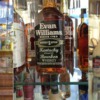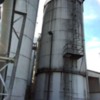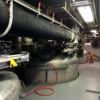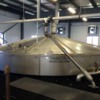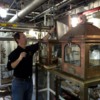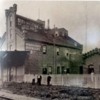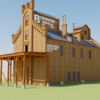Having my daughter living next door to the owner of the largest privately held distilled beverages industry in the country has it's advantages. Having a private tour of their distillation operation in West Louisville, was one of the those. Heaven Hill has their operation split into two parts. After a devastating fire in the early 90s totally destroyed their distillation operation in Bardstown, KY an opportunity presented itself to buy a going distillery in Louisville that was no longer needed. After a complete modernization, operations began in 2000. The grain is brought to this plant, made into 136 proof un-aged Bourbon and then trucked to the barreling and bottling plant in Bardstown. While it is privately held and not as large as Jim Beam or Brown-Foreman, Heaven Hill is no light weight.
I was wrong in my facts about the barreling challenge in my previous post. They now have 1.1 million barrels in aging warehouses, and the cost of a new—and they must be new to make Bourbon—oak barrel is now $170.00. That's almost $200 million just in the barrels, forget about the cost of the liquor that inside of them. And none of this can be used until it is aged at least four years. They don't sell Bourbon that less than 8 years-old.
It's an interesting plant due to the fact that the front half is entirely organic and involves basically food, and the back half is chemical with the distillation of the fermented. The plant consumes about 100 bushels of corn a day that is trucked in from five local farms. Sometimes they get corn from other sources, but that's the exception not the rule. In addition to corn, and Bourbon must be 51% corn-based or it's not Bourbon, they bring in wheat, rye and malted barley. Wheat or rye is used, but not both since they make different tasting products with each.
The raw materials are stored as whole grains until ready to be put into the masher at which time they milled to a particle size of coarse flour. They need to expose as much of the starch as possible. Water, corn, a residual from the previous fermenting operation, the malted barley and rye goes into the masher where it's cooked using steam for a few hours. The malted barley is not there for flavor. It generates a natural enzyme that breaks up the long chain starch molecules into simple sugars upon which the yeast can do its magic.
Once the mash is properly cooked—it's called "beer", and frankly, that's what it is—it is pumped into the fermenters. There are three mashing vessels and 9 fermenters. It takes 9 mash batches to fill one fermenter. The ferementers are all 124,000 gallons. In addition to the mash, the ferementer gets the yeast. It stays in the fermenter for four to six days depending on the day of the week. At this time, Heaven Hill is running 24 hours a day for five days as week. The 6-day cycle gets them through the weekends. You can control the fermentation by allowing the temperature to increase or decrease. They are going to a 7-day operation since Bourbon demand is through the roof. They employ 60 people at the distillery.
The mashing process is endothermic. You're basically making soup and cooking the ingredients. It is then cooled from about 140º F down to about 65º F in a cooling loop prior to fermentation. Fermentation is an exothermic process. There are stainless steel cooling coils inside the fermenter to maintain the temperature best enjoyed by the yeast...about 80º F. If you did not actively cool the batch, the fermentation reaction would run away, and ultimately kill the yeast and make terrible bourbon.
Once the fermented mash reaches about 8 or 9 proof (16 to 18% alcohol) it pumped into the distillation train. They use two 45 foot tall trayed distillation towers that separate the alcohol from the fermented mash. After passing through both columns, it goes to a "doubler" or "Thumper" which is an old fashioned pot distillation arrangement where the alcohol vapors bubble through water heating the water and exciting as vapor at the top. From there they go to condensers, the proofing station, and out-bound product storage before going to the Bardstown barreling operation.
The plant is entirely digital control and two men in the control room can run the whole operation. The plant was spotless! Safety equipment was prevalent, and equipment was in great shape. It was one of the neatest operations I'd seen, and I've seen over 100 chemical and manufacturing operations in my career. All operators are trained and certified on all operations and they rotate once a week. They don't receive anything by rail even though there is a spur on the property. Grain is brought into a large storage facility in town that serves all of the alcoholic beverage manufacturers in the area. It's only five blocks from Heaven Hill and they truck the material from there to the plant. Dennis Potter, the plant manager, estimates that they'd probably use about 2 hoppers of grain per day.
The most important item in this product chain besides managing 1.1 million barrels, is the yeast. Their strain is over 70 years old. Instead of growing it themselves, they use the services of a European company who has their original stock, produces the yeast and ships it in dry form to the plant. It's is kept in a refrigerator. 5 bags of yeast are used per each charging of the fermenter. Each bag is 5 kilos.
These are some of the many Heaven Hill Brands. If any of your are Bourbon drinkers, you may know Elijah Craig. It's a great 18 year old Bourbon
Grain Silos contain enough material for about 5 days of operation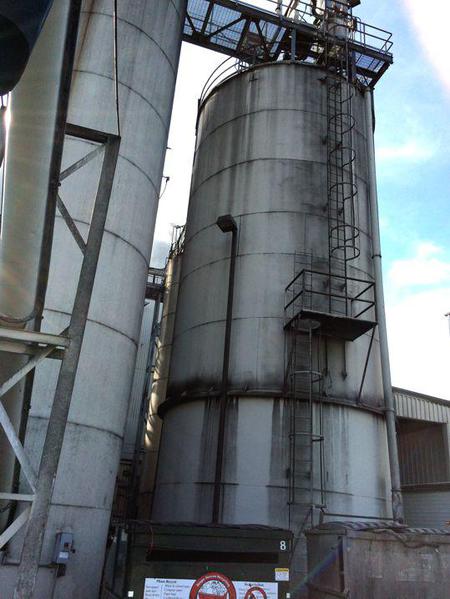
Mashing Vessels. Grain is loaded into the mashers using screw augers that run in the black channels running over the tops of the mashers. This is a "Sour Mash" Bourbon process. It's known by this name from the re-cycled mash that comes from the bottom of the distillation column. There is very little sugar left in this and it tastes very sour. It's used to kick start the enzyme reaction and to help maintain the low p.H. value in the masher.

Fermenting Vessels. After each batch the fermenters are washed, and sterilized. This is to ensure that each batch is separate and unique facilitating trouble shooting any problems that might arise. They're on the constant lookout for stray biologicals that can make product spoiled. If the fermenters weren't cleaned properly, residual with a problem could be transferred from batch to batch making it very difficult to find out when or how the problem happened.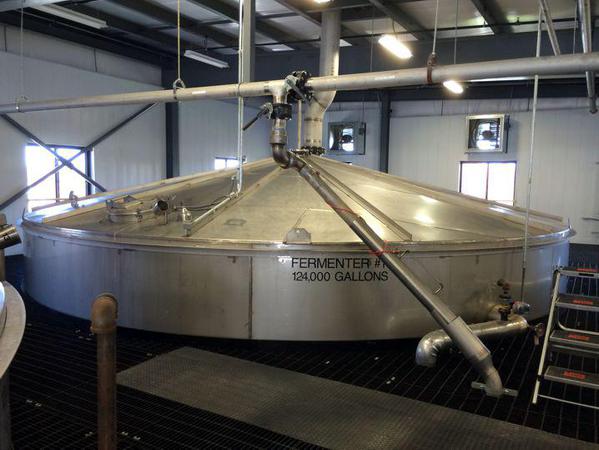
Dennis Potter taking a sample from the proofing station. Because they stop the fermentation at 8 proof, there's a lot of flavor in the un-aged alcohol. I was surprised. You can easily taste the corn. In the past, the government inspector would take a daily sample at these stations which is why the locks are there. But in modern times, it is done much less frequently. They are taxed based on the proof they're producing.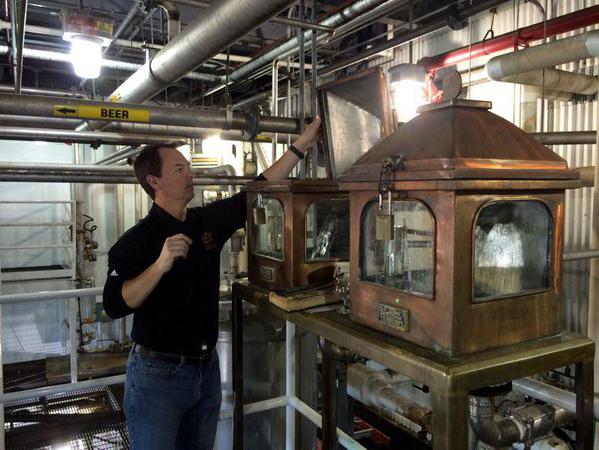
How I'm going to incorporate all of this into a decent structure for my railroad remains to be seen, but knowing myself, I will give it one heck of a try. I'll keep you posted (of course) on any and all progress.




